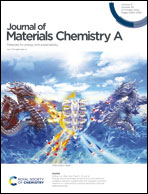Molecular engineering for constructing a D–A system and enhancing delocalization in g-C3N4 with superior photocatalytic activity†
Abstract
A facile “one-pot” method by the Schiff base reaction to construct the D–A structure and enhance the delocalization in the conjugated polymer matrix, g-C3N4, is reported. The modified g-C3N4 (UCN-xTDA) derived from the copolymerization of thiophene-2,5-dicarbaldehyde (TDA) with urea can promote the transfer and separation of photogenerated carriers and improve the utilization efficiency of photons under visible light. We find that the rate constant for the photodegradation of BPA for optimal UCN-5TDA is 14.4 times that of UCN. Importantly, the average H2 evolution rate of UCN-5TDA is about 12.35 mmol h−1 g−1 under visible light irradiation, and the apparent quantum efficiency (AQE) can reach 13.3% at 450 nm and 7.93% at 500 nm, which are much better than those of most previously reported g-C3N4-based photocatalysts. In addition, the remarkable improvement of hydrogen evolution can also be evidenced by polymerizing different precursors (dicyandiamide, melamine, and thiourea) with TDA, indicating that our strategy is universal. The work provides not only insights into the construction of a D–A system and delocalized structures in g-C3N4 to improve photocatalytic activity but a general strategy to design novel photocatalysts.



 Please wait while we load your content...
Please wait while we load your content...